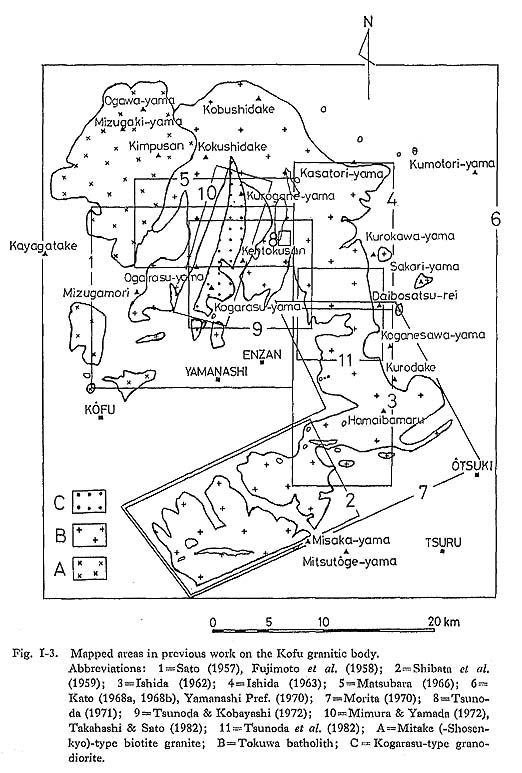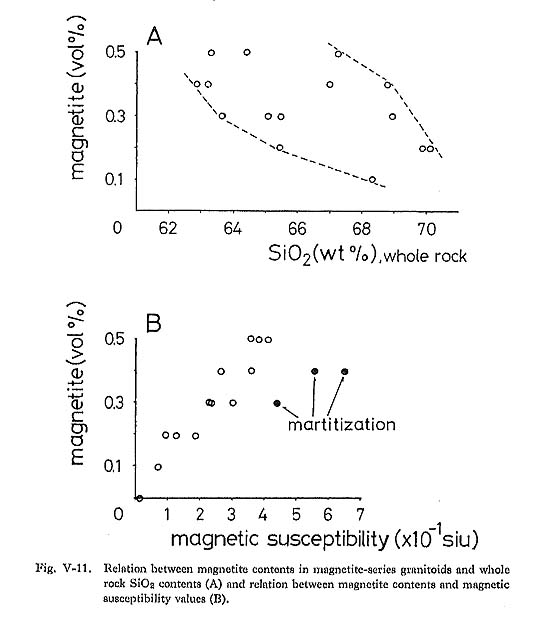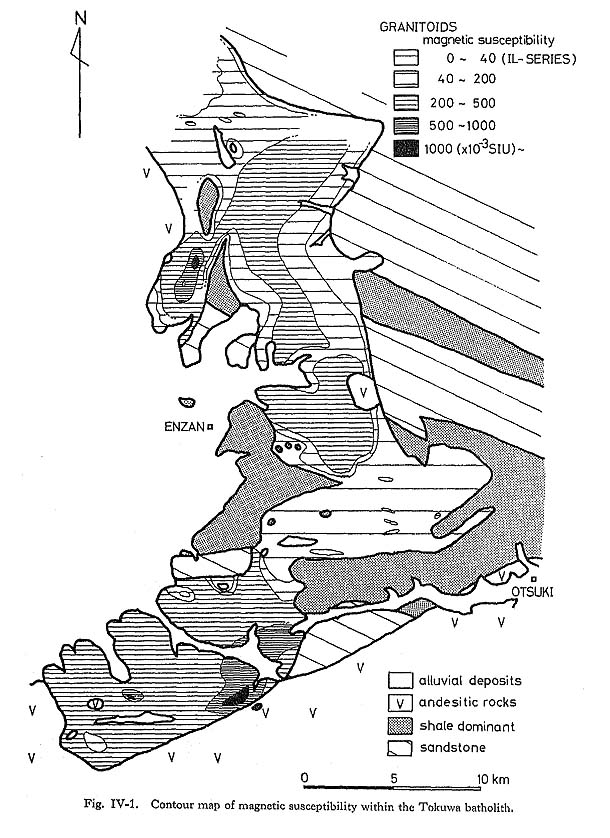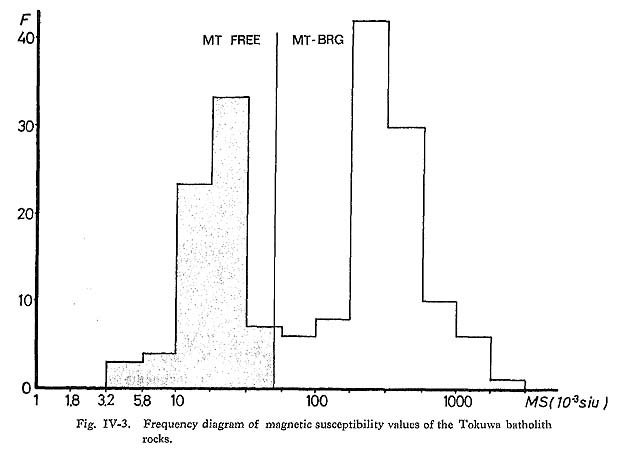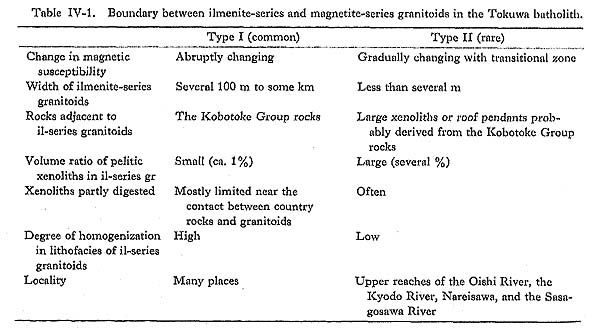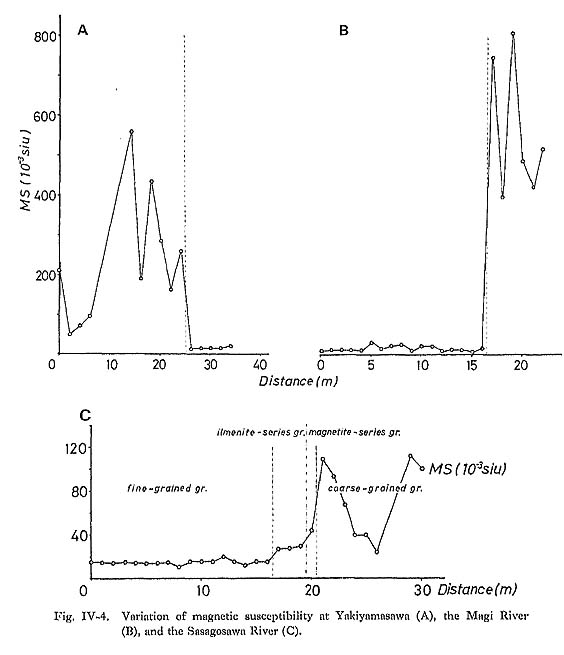CHAPTER IV
Distribution and Mutual Relation between Ilmenite-Series and Magnetite-Series Granitoids in the Tokuwa Batholith
|
Tokuwa batholith rocks occur widely to the east of the Kofu Basin (Fig. I-3). Several small masses of granitoids, probably plugs of the Tokuwa batholith, occur at places such as Kurokawa-yama, Sakari-yama, the Hurukonba hut (about 1.6 km west of Daibosatsurei), Mito-san, and Ogi-yama (last two are not shown in Fig. I-3). The existence of two series of granitoids in the Tokuwa batholith was first recognized by Ishihara et al. (1976). However, no detailed distribution of the two series of granitoids and the mutual relations between them has been reported.
As shown by Kanaya and Ishihara (1973), the magnetic susceptibility of the Tokuwa batholith rocks as measured in the field has good correlation with the magnetite content of the granitoids (see Fig. V-11-B). The present author measured the magnetic susceptibility of the granitoids within the entire batholith by using a Kappameter KT-3 (a magnetic susceptibility measuring device; see Ishihara, 1979). Special care was taken to place the Kappameter KT-3 perpendicular to the surface of outcrops and a "distance stick" (a device for avoiding inaccuracies due to irregularity of outcrop surfaces) was also used.
Figure IV-1 shows the areal variation of magnetic susceptibility of the Tokuwa batholith rocks obtained by this method, drawn from 1,200 measured points as reported by Shimizu and liyama (1981a), The presence or absence of magnetite in about 600 representative specimens was checked microscopically (Fig. IV-2), A detailed iso-magnetic susceptibility map (Fig. IV-1) shows the existence of several centers with high values in the batholith and also shows gradational variations from high to low values throughout the batholith including the two granitoid series. The magnetic susceptibility of the rocks in the center of the batholith is relatively high.
A histogram of measured magnetic susceptibility indicates a bimodal distribution with threshold values of magnetic susceptibility being M=40 to 50 × 10-3 SI units (Fig. IV-3). Careful microscopic examination of 305 samples revealed that the samples of which the M values are higher than 50 × 10-3 SI units contain both magnetite and ilmenite, and those with M values of less than 40×10-3 SI units contain only ilmenite. The value of M=45 × 10-3 SI units is therefore taken in this paper to be the boundary value for distinguishing ilmenite-series rocks from magnetite-series rocks of the Tokuwa batholith.
As shown in Fig. IV-1, the marginal parts of the batholith indicate marked variability in magnetic susceptibility. This variation has a strong correlation with rock fades of country rocks in contact with granitoids. The values of magnetic susceptibility of granitoids in contact with shale and sandstone are relatively low, whereas those in contact with andesitic rocks are fairly high. According to the above criterion, the central parts of the batholith are composed of magnetite-series rocks and rocks near the contact with sedimentary rocks of the Kobotoke Group and the Shimanto Supergroup are always ilmenite-series rocks. The ilmenite-series granitoids are developed extensively near the contact with shale-dominant portion of the Kobotoke Group. The distribution width of the ilmenite-series granitoids, which is more than 600 m at the minimum (Type I in Table IV-1), is wider when they are in contact with the shale-dominant portion of the Kobotoke Group than when in contact with the sandstone portion of the group. The areal distributions of the two series of rocks seem to be controlled by country rocks.
A particularly detailed survey was performed near the boundaries between the two rock series. No lithological difference has been observed along the boundary between magnetite-series and ilmenite-series granitoids of the Tokuwa batholith except at the upstream portions of the Magi and the Sasagosawa Rivers. Figures IV-4-A, -B, and -C show some of the results at Yakiyamasawa, across the Magi and the Sasagosawa Rivers. The value of magnetic susceptibility changes suddenly from ilmenite-series to magnetite-series sides (Type I in Table IV-1). A gradual change in magnetic susceptibility has been only rarely observed (Type II in Table IV-1).
Magnetic susceptibility of xenoliths and country rocks in contact with the two series of granitoids were also measured: sedimentary rocks and their derivatives have low values of magnetic susceptibility, whereas igneous rocks of the Misaka Group and their derivatives and xenoliths of unknown igneous origin including presumable autoliths have high values of magnetic susceptibility. The correlation between magnetic susceptibility and rock facies of country rocks leads to the tentative conclusion that ilmenite-series granitoids of the Tokuwa batholith were generated, at least to some extent, by assimilation of country rocks into magnetite-series melt. Therefore, it is necessary to study the petrography and geochemistry of Tokuwa batholith rocks and the mineralogy of their rock-forming minerals in detail in order to evaluate the reciprocal relation between the melt and the country rocks. |
